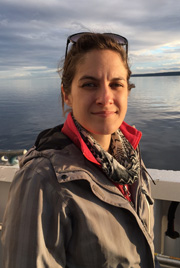Striking Balance: Exploring Canada's biosphere reserves
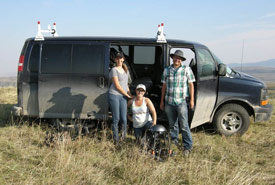
The crew at Shoderee Ranch at Waterton, with the trusty van. (L-R) - Director of Photography - Ann Tipper, Producer - Yvonne Drebert, Director - Zach Melnick (Photo by Larry Drebert)
Making movies and TV shows is glamorous. Unless of course, you’re making documentary, public television. In that case, you may find yourself driving across the country in a late-model cargo van for weeks, or months at a time; accompanied by two of your best friends, whom you’re not so sure about after having spent months together, in a van. Each day starting and ending with the rise and fall of the sun, and a dinner squeezed in before crashing into bed.
That was the scenario, in mid-September of 2014, when I made the drive from Redberry Lake, Saskatchewan to Waterton, Alberta with my trusty crew: Director Zach Melnick, and Director of Photography Ann Tipper. At this point, we had been on the road for a month and a half, filming the documentary series, Striking Balance — an 8x50 minute series on Canada’s biosphere reserves.
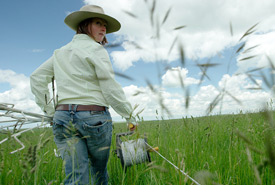
Julia Palmer is one of the ranchers working with the NCC in Waterton. The dense, lush, waist high, grass on her ranch is a testament to her stewardship on the land. (Photo by Ann Tipper and Zach Melnick)
It was getting well past midnight by the time we turned off the highway to our destination – a house just beyond the borders of Waterton Lakes National Park. An early snowfall had hit the day before, dressing the mountains in a veil of white; illuminating the scenery in spite of the late hour. As we slowed, the crew perked up with the anticipation of warm beds after many hours of driving.
But our yearning for release was quickly replaced by awe, with the arrival of a mountain lion and two adolescent cubs on the road, mere metres before us. Being Ontarians, none of us had ever seen a mountain lion before, let alone three at once. We just sat there as the minutes (ok, maybe seconds!) ticked by, watching the amazing creatures, who were considerably less interested in us. Eventually, the mountain lions left the road, and we continued the short distance to our destination, now wide awake.
The Nature Conservancy of Canada (NCC) had set up the accommodations for us as part of our partnership on the Striking Balance project; something we could not have been more thankful for as we promptly fell into bed upon our arrival.
It wasn’t until the morning that we noticed the house rules on the kitchen table, one of which stated that the front gate was always to be kept closed — something we had neglected to do in the excitement of the night before. The rule went on to say that any cattle that escaped from the field surrounding the house would be the responsibility of the occupants. Horrified that we might have let the cows out, and having no clue about cow replacement costs, I rushed to the end of the driveway and slammed the gate. Thankfully, it turned out there had been no cattle in the field that night.
From these experiences, an understanding of how this landscape functioned began to emerge. Cows, mountain lions and ranchers were all sharing this country; and evidently, it was working.
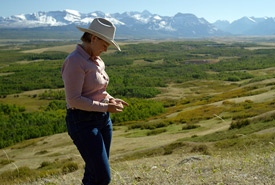
Kathy Flundra, checks on her grass at the height of her ranch, a part of the Park Front Project. The mountains of Waterton complete the vista. (Photo by Ann Tipper and Zach Melnick)
Over the coming weeks, we learned about the evolution of the Waterton Park Front, which included the land around “our house.” There’s lots of great information on the NCC website about this project, but the upshot is that just beyond the borders of Waterton Lakes National Park, the NCC has created a buffer of land, through various conservation tools, that will help protect and maintain the ecological integrity of the Waterton area.
So what does that mean? It means that some of that land is actively ranched, with cattle helping to maintain the prairie landscape, which would otherwise be overgrown by encroaching aspen. Here, people are an active part of the “conservation equation.”
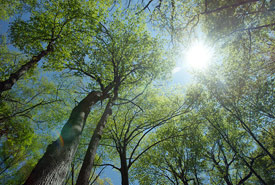
The breathtaking Backus Woods in Ontario. One of the best examples of Carolinian old-growth forest in the country. (Photo by Ann Tipper and Zach Melnick)
This was a formula we would witness throughout the country. In Ontario, the Backus Woods were always bustling with people, and in the Bay of Fundy the spectacle of thousands of migrating birds was bolstering the tourism economy, while educating both local and visitor populations on how to respect these magnificent animals.
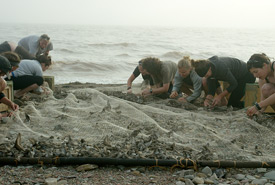
Researchers collect peeps on the Bay of Fundy, in an effort to better understand the needs of the birds and their population numbers. The work is being done in partnership between Mount Allison University, the Canadian Wildlife Service and the Nature Conservancy of Canada. Tourists watch the researchers at work from the NCC visitors’ centre, at a safe distance from the birds. (Photo by Ann Tipper and Zach Melnick)
The idea that we need to look at ourselves as part of the environment, and not outside of it, became more and more clear as we continued our work, and ultimately became the focus of our show.
Check out Striking Balance on TVO and the Knowledge Network this fall to see how eight communities across the country are doing their best to find their own answers to the “conservation equation.” It just might change the way you think about the natural world, and our place in it.
For broadcast dates and free community screening information: www.strikingbalance.ca.

